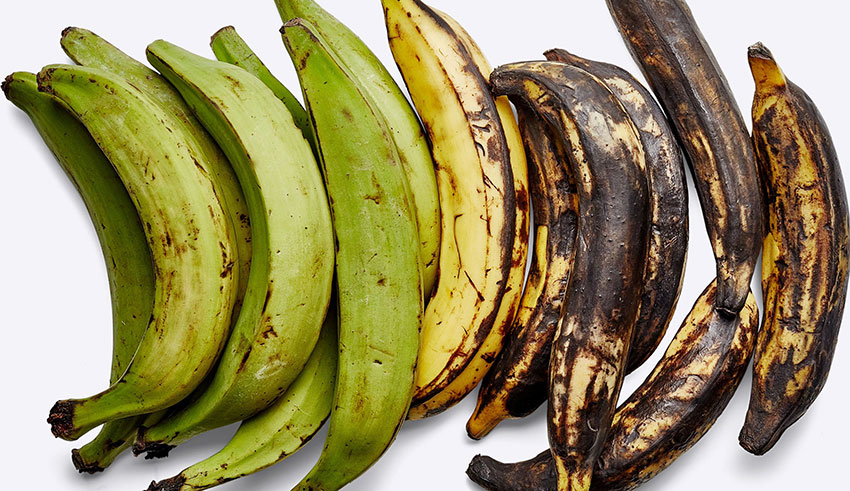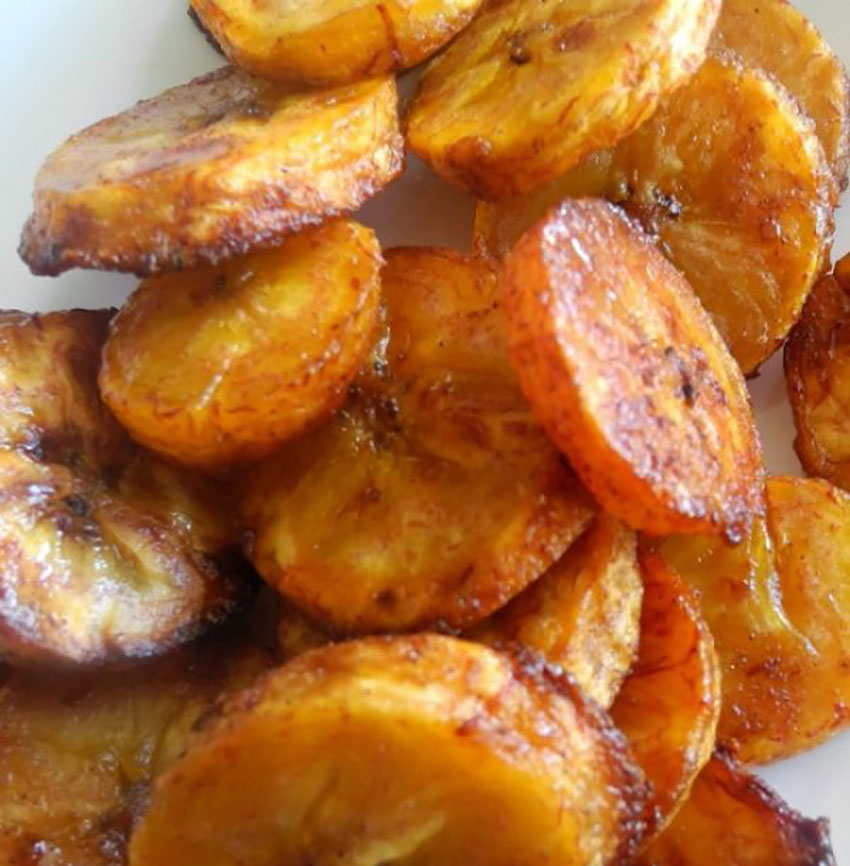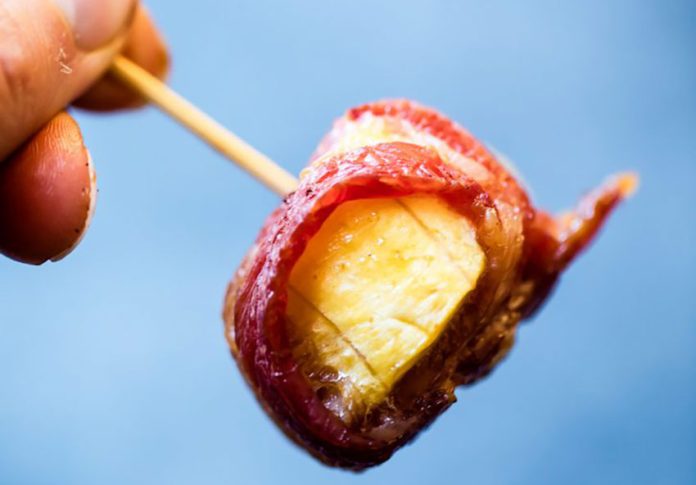The first time I ate plantains other than as chips was in Jamaica, many moons ago. I was on a press trip, and we’d been invited to a private home to have a home-cooked dinner of traditional local dishes.
One was a sort of stew, where instead of potatoes there were chunks of plantain. Slightly sweet, with a dense potato-like texture, they added a wonderful flavor to the spicy, savory mixture of vegetables and beef. I actually couldn’t figure out what they were and asked the host, who explained they were green plantains, used instead of potatoes, which don’t grow in the island’s hot tropical climate.
Since then, and especially since moving to Mexico, I’ve had plantains (platanos machos) cooked in many ways. One of my favorites is grilled in brochettas (what we’d call shish kebabs). Here in Mazatlán, vendors sell plantains baked in rolling ovens, which they serve drowned in sweetened condensed milk. I’ll buy them plain, then take them home to add butter and a bit of salt instead.
The first thing you need to know about this starchy cousin to the banana is that it’s completely different from the yellow fruit favored by monkeys. Plantains have a much higher starch content, and so must be cooked before eating. The texture and mouth-feel is more like a slightly sticky potato.
What happens, though, is that as they ripen the starches turn into sugars, and when cooked or fried those sugars caramelize and create an even sweeter yumminess. Depending on the stage of ripeness – which you judge by the color of the skin – your finished product will be more or less sweet. Plantains start out green, go to yellow and then turn completely black.

The peel is thick and hard, and not easily peel-able like a “dessert” banana. Cut off the top and bottom ends with a sharp knife, then score one section from tip to tip and pry it back carefully with the knife. Once you have one section off, the rest should come easier and you can probably just use your fingers.
Peeling gets a little easier when they’re riper but you’ll still need to start with a knife. When the skin is very yellow or really black, it comes off easily and the plantain inside is sticky, soft and sweet; when fried, they’ll have pudding-soft insides and caramelized edges.
Plantains grow all over the Caribbean, West Africa and Latin and South America. In Puerto Rico and Cuba, you find mofongo, smashed fried green plantains with garlic and fried pork skin; in the Dominican Republic’s mangú they’re part of the traditional Las Tres Golpes breakfast; and in Ghana, where plantains are called “vegetarian meat,” street vendors hawk paper cones of spicy kelewele.
Pumpkin Spice Plantain Chips
Everybody’s favorite flavor, tropical style!
- 2 ripe plantains
- 2 tsp. coconut oil, melted
- 1 tsp. cinnamon
- ½ tsp. nutmeg
- ½ tsp. allspice
- 1/8 tsp. cloves
- 1 tsp. sugar
- Salt
Preheat oven to 375 F. Peel and slice plantains thinly. Place in bowl, add coconut oil and mix well. Stir in spices. Carefully lay plantain slices on cookie sheet lined with parchment or lightly greased. Sprinkle with salt. Cook 20-25 minutes until crispy. Watch carefully as they burn easily.

Bacon-Wrapped Plantain Bites
- 2 very ripe plantains
- 12 oz. uncooked bacon
- 1-2 Tbsp. maple syrup
Preheat oven to 375 F. Line a baking sheet with foil or parchment. Peel, then slice plantains into ½-inch chunks. Cut strips of bacon in half. Wrap each plantain chunk with ½ piece of bacon. Carefully place rolls on baking sheet, seam side down. Brush each with a little maple syrup. Bake for 30-40 minutes until bacon is crispy. Stick a toothpick in each and serve. – www.ambitiouskitchen.com
Caribbean Plantain & Bean Boats
- 2 Tbsp. coconut oil
- 2-4 cloves garlic, minced
- ¼ cup thinly sliced red onion
- ½ tsp. ground cumin
- Salt & pepper
- 1 cup sweet corn
- About 2 cups cooked or canned black beans
- 1 cup cherry tomatoes, halved
- 1 jalapeno, chopped
- 2-4 medium-ripe plantains
Preheat oven to 375 F. Without peeling, slice plantains in half longways, drizzle with olive oil and sprinkle with salt. On a greased baking sheet, lay the sliced plantains, skin on, face-down. Bake for 35 minutes or until fork tender. –www.nutritionstripped.com
Meanwhile, in a small pot, cook coconut oil, garlic, and onion for about 7 minutes or till onion begins to brown. Add corn, beans, tomatoes, cumin, salt, pepper and jalapeno. Cook for 10 minutes, adjusting seasonings to taste.
Once plantains have finished baking, remove the skin. Top with bean and corn mixture, and garnish with fresh cilantro, sliced avocado and a squeeze of fresh lime juice. Serve warm with rice or salad.
Cinnamon-Caramel Baked Plantains
If you like, top this easy dessert with whipped cream or vanilla ice cream.
- 2 very ripe plantains
- 2 Tbsp. coconut oil, melted
- 1-2 Tbsp. sugar or grated piloncillo
- 1 tsp. cinnamon
- ¼ tsp. salt
Preheat oven to 350 F. Peel plantains and cut into rounds about ¼-inch thick. In a bowl, toss gently with coconut oil. Lightly grease a baking sheet and spread out plantains in a single layer. Combine sugar, cinnamon and salt. Sprinkle evenly over plantains. Bake for about 25 minutes, turning once. Check often to make sure they don’t burn. Remove from oven, let cool and serve warm.
Baked Plantain Cubes
Use as a taco or tostada filling, on a salad, as a garnish for chili or just as a delicious snack.
Preheat oven to 400 F. Peel and slice unripe plantains into small cubes. In a bowl, drizzle with a little olive or coconut oil. Toss to mix and transfer onto a greased baking sheet. Bake for 20-25 minutes, stirring a few times, until browned and slightly crispy.
Janet Blaser of Mazatlán, Sinaloa, has been a writer, editor and storyteller her entire life and feels fortunate to write about great food, amazing places, fascinating people and unique events. Her work has appeared in numerous travel and expat publications as well as newspapers and magazines. Her first book, Why We Left: An Anthology of American Women Expats, is available on Amazon. Contact Janet or read her blog at whyweleftamerica.com.
